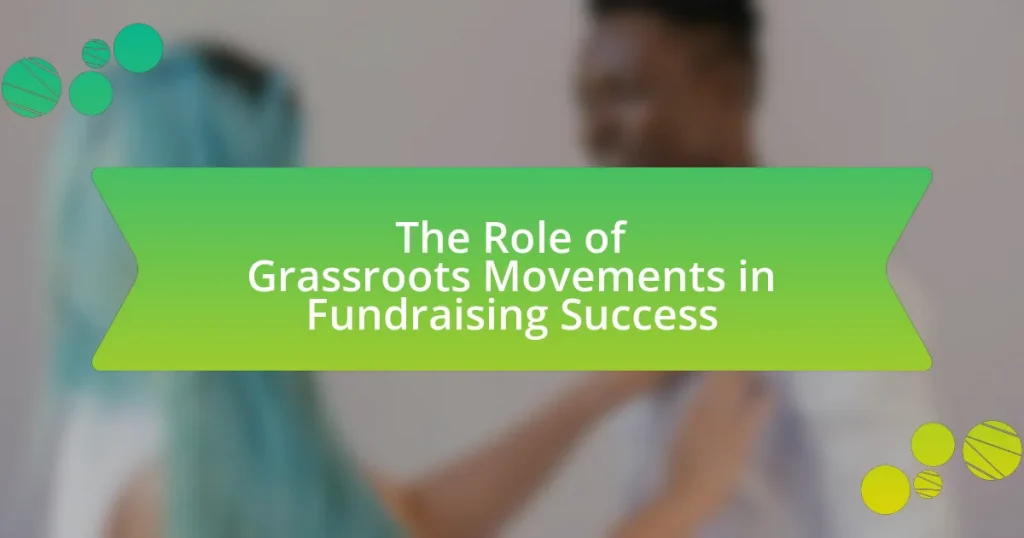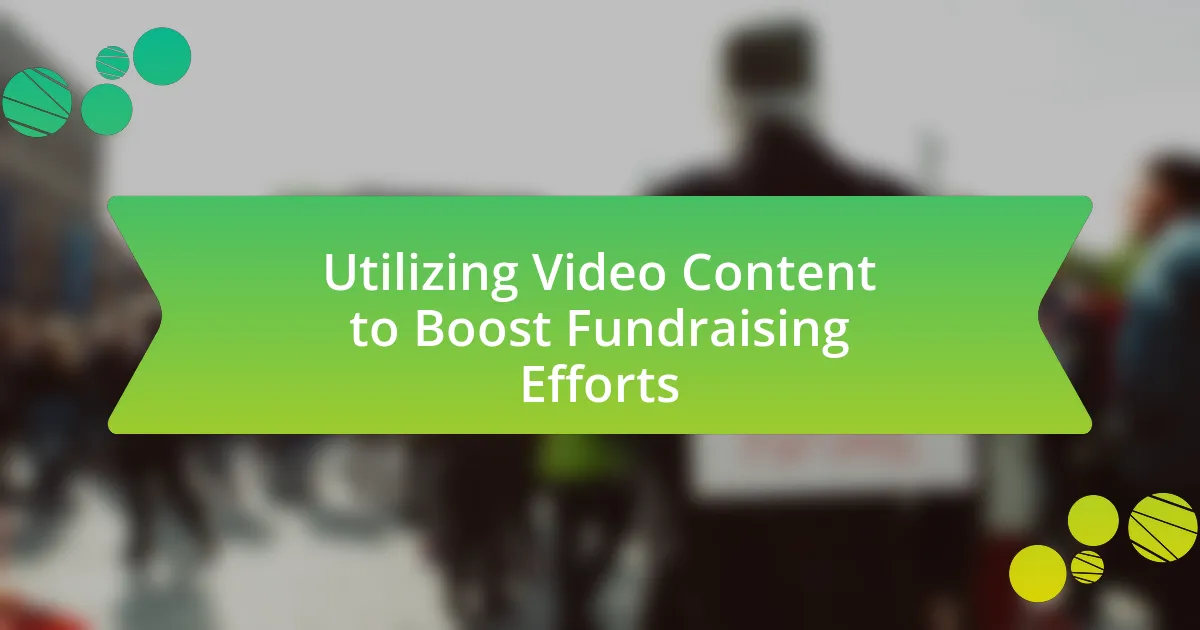Grassroots movements are community-driven initiatives that advocate for social, political, or environmental change, playing a crucial role in fundraising by mobilizing local support and encouraging small-scale contributions. This article explores the distinct characteristics of grassroots movements, their effectiveness in engaging communities, and the strategies they employ to enhance fundraising success. It also addresses the challenges these movements face, such as limited resources and donor fatigue, while highlighting best practices for successful fundraising campaigns. Key elements discussed include the importance of storytelling, social media engagement, and community involvement in building trust and credibility with donors.
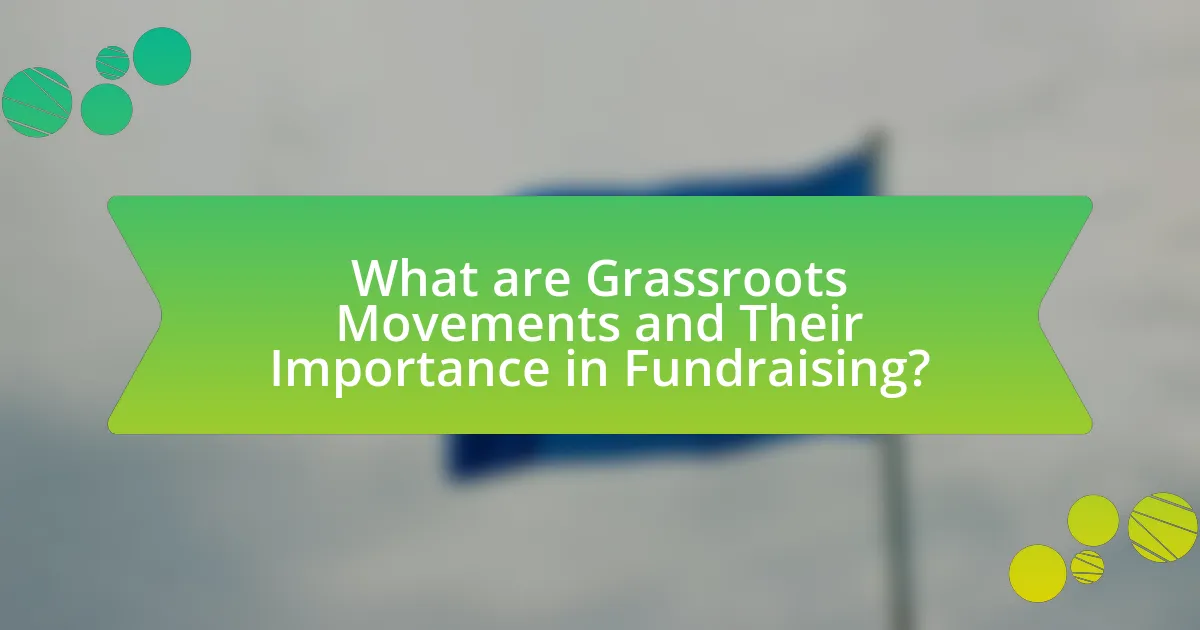
What are Grassroots Movements and Their Importance in Fundraising?
Grassroots movements are organized efforts by individuals at the community level to advocate for social, political, or environmental change, often relying on local support and volunteer engagement. Their importance in fundraising lies in their ability to mobilize large numbers of people, creating a strong base of support that can lead to significant financial contributions. For instance, the 2018 campaign for the U.S. House of Representatives saw candidates like Alexandria Ocasio-Cortez raise substantial funds through small donations from grassroots supporters, demonstrating that grassroots movements can effectively leverage community engagement to achieve fundraising success.
How do grassroots movements differ from traditional fundraising methods?
Grassroots movements differ from traditional fundraising methods primarily in their reliance on community engagement and small-scale contributions rather than large donations from a few wealthy individuals or organizations. Grassroots movements typically mobilize individuals at the local level, fostering a sense of ownership and collective action, which can lead to a broader base of support. For example, a study by the Stanford Social Innovation Review found that grassroots campaigns often raise funds through small donations from a large number of supporters, which can create a more sustainable funding model compared to traditional methods that depend on major donors. This approach not only democratizes fundraising but also enhances community involvement and advocacy, making it a powerful tool for social change.
What characteristics define a grassroots movement?
A grassroots movement is characterized by its community-driven nature, where individuals mobilize at the local level to advocate for social, political, or environmental change. These movements typically emerge from the collective efforts of ordinary people rather than established organizations or leaders, emphasizing participation and inclusivity. For instance, the Civil Rights Movement in the United States was largely grassroots, with local activists organizing protests and campaigns that led to significant legislative changes. This bottom-up approach fosters a sense of ownership among participants, enhancing engagement and commitment to the cause.
Why are grassroots movements effective in mobilizing community support?
Grassroots movements are effective in mobilizing community support because they foster a sense of ownership and empowerment among local individuals. This localized approach encourages participation by directly involving community members in decision-making processes, which enhances their commitment to the cause. Research indicates that grassroots initiatives often leverage personal connections and shared experiences, making the message resonate more deeply with the community. For instance, a study by the Stanford Social Innovation Review found that grassroots campaigns can increase engagement by up to 50% compared to top-down approaches, demonstrating their effectiveness in rallying support.
What role do grassroots movements play in enhancing fundraising success?
Grassroots movements significantly enhance fundraising success by mobilizing community support and fostering a sense of ownership among donors. These movements leverage local networks and personal connections, which can lead to increased engagement and contributions. For instance, a study by the Stanford Social Innovation Review found that organizations with strong grassroots support raised 50% more funds than those without such backing. This demonstrates that grassroots movements not only amplify fundraising efforts but also create a sustainable donor base through community involvement and advocacy.
How do grassroots movements build trust and credibility with donors?
Grassroots movements build trust and credibility with donors by demonstrating transparency, accountability, and community engagement. These movements often share detailed information about their initiatives, financials, and impact, which fosters a sense of openness. For instance, a study by the Stanford Social Innovation Review highlights that organizations that regularly communicate their successes and challenges are more likely to retain donor support. Additionally, grassroots movements often involve local community members in decision-making processes, which enhances their legitimacy and shows donors that their contributions directly benefit the community. This participatory approach not only strengthens relationships with existing donors but also attracts new supporters who value authentic engagement and social impact.
What strategies do grassroots movements use to engage supporters?
Grassroots movements engage supporters through strategies such as community organizing, social media campaigns, and direct outreach. Community organizing involves mobilizing local individuals to participate in collective actions, fostering a sense of ownership and commitment. Social media campaigns leverage platforms like Facebook and Twitter to spread awareness, share stories, and create viral content that resonates with potential supporters. Direct outreach includes door-to-door canvassing, phone banking, and hosting events to build personal connections and encourage participation. These strategies have proven effective; for instance, the grassroots campaign for Barack Obama in 2008 utilized social media and local organizing to mobilize millions of supporters, demonstrating the power of these engagement tactics in achieving fundraising and electoral success.
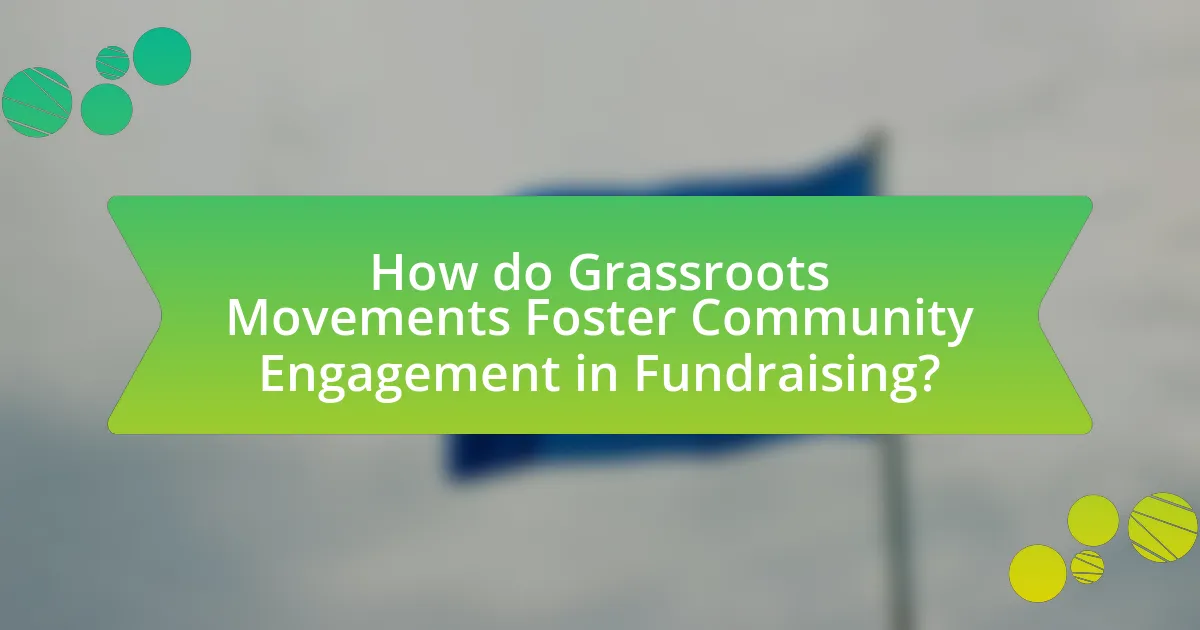
How do Grassroots Movements Foster Community Engagement in Fundraising?
Grassroots movements foster community engagement in fundraising by mobilizing local individuals around shared causes, creating a sense of ownership and collective responsibility. These movements often utilize social networks and community events to raise awareness and funds, which enhances participation and investment in the cause. For instance, a study by the Stanford Social Innovation Review highlights that grassroots campaigns can increase donor engagement by 50% compared to traditional fundraising methods, as they leverage personal connections and local narratives to inspire action. This localized approach not only builds trust but also encourages sustained involvement, making community members feel integral to the fundraising process.
What methods do grassroots movements employ to connect with their communities?
Grassroots movements employ methods such as community organizing, social media engagement, and local events to connect with their communities. Community organizing involves mobilizing individuals around shared interests or issues, fostering a sense of belonging and collective action. Social media engagement allows grassroots movements to reach a wider audience, share information quickly, and facilitate discussions, which is crucial for building relationships and raising awareness. Local events, such as town hall meetings or workshops, provide opportunities for face-to-face interaction, enabling movements to gather feedback and strengthen community ties. These methods are effective as they create a participatory environment, encouraging community members to become actively involved in the movement’s goals and initiatives.
How do local events contribute to fundraising efforts?
Local events significantly enhance fundraising efforts by fostering community engagement and generating direct financial support. These events create opportunities for individuals to connect with the cause, often leading to increased donations. For instance, a study by the Association of Fundraising Professionals found that 70% of donors are more likely to contribute when they feel a personal connection to the event or organization. Additionally, local events often attract media attention, which can amplify outreach and encourage broader participation, further boosting fundraising outcomes.
What role does social media play in grassroots fundraising campaigns?
Social media serves as a crucial tool in grassroots fundraising campaigns by enabling organizations to reach a wider audience quickly and cost-effectively. It facilitates direct engagement with potential donors, allowing campaigns to share their mission, updates, and calls to action in real-time. For instance, a study by the Pew Research Center found that 69% of adults in the U.S. use social media, providing a vast platform for grassroots movements to mobilize support and donations. Additionally, social media allows for the sharing of personal stories and testimonials, which can significantly enhance emotional connections and drive contributions.
How can grassroots movements leverage storytelling for fundraising success?
Grassroots movements can leverage storytelling for fundraising success by creating emotional connections with potential donors through relatable narratives. These narratives often highlight personal experiences, community impact, and the urgency of the cause, making it easier for supporters to understand the significance of their contributions. Research indicates that campaigns utilizing storytelling can increase donations by up to 300%, as they resonate more deeply with audiences compared to traditional fundraising methods. By sharing authentic stories that illustrate the challenges faced and the positive outcomes achieved, grassroots movements can effectively engage their audience, fostering a sense of community and encouraging financial support.
What types of stories resonate most with potential donors?
Personal stories that highlight individual impact resonate most with potential donors. These narratives often showcase the direct benefits of donations, illustrating how contributions can change lives or support specific causes. Research indicates that emotional storytelling, particularly those that evoke empathy and connection, significantly influences donor engagement and willingness to give. For instance, a study by the Stanford Social Innovation Review found that stories emphasizing personal experiences and outcomes can increase donations by up to 50%.
How can personal narratives enhance the emotional appeal of fundraising efforts?
Personal narratives enhance the emotional appeal of fundraising efforts by creating a relatable connection between donors and the cause. When individuals share their personal stories, they evoke empathy and compassion, making the cause more tangible and urgent for potential supporters. Research indicates that emotional storytelling can increase donations by up to 50%, as it allows donors to see the direct impact of their contributions on real lives. This connection fosters a sense of community and shared purpose, motivating individuals to contribute to grassroots movements that resonate with their values and experiences.
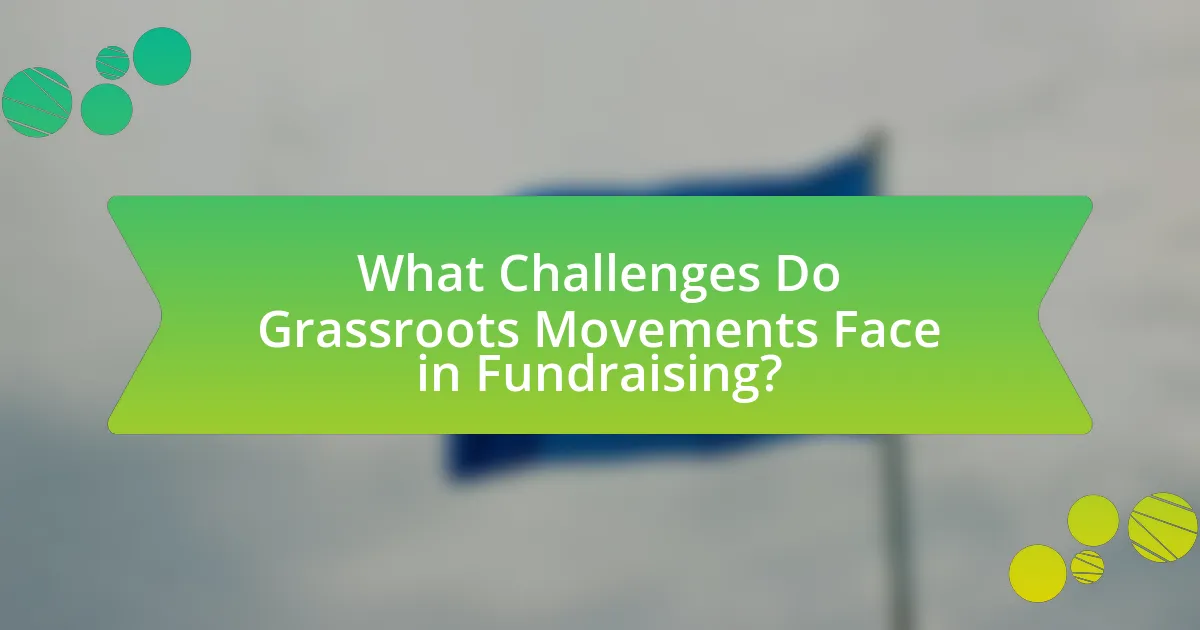
What Challenges Do Grassroots Movements Face in Fundraising?
Grassroots movements face significant challenges in fundraising, primarily due to limited access to financial resources and established donor networks. These movements often rely on small donations from individuals, which can be inconsistent and insufficient for sustaining operations. Additionally, grassroots organizations frequently lack the marketing and outreach capabilities that larger organizations possess, making it difficult to reach potential donors. According to a report by the National Committee for Responsive Philanthropy, grassroots organizations receive only a small fraction of total philanthropic funding, highlighting the disparity in financial support. Furthermore, grassroots movements may struggle with regulatory hurdles and compliance issues related to fundraising, which can divert attention and resources away from their core missions.
What common obstacles hinder grassroots fundraising initiatives?
Common obstacles that hinder grassroots fundraising initiatives include limited resources, lack of visibility, and donor fatigue. Limited resources often restrict the ability to reach potential donors effectively, as many grassroots organizations operate with minimal budgets and manpower. Lack of visibility can prevent grassroots initiatives from gaining traction, as they may struggle to compete with larger, more established organizations that have greater media presence and marketing capabilities. Donor fatigue occurs when potential supporters become overwhelmed by frequent requests for contributions, leading to decreased engagement and support for grassroots efforts. These factors collectively impede the success of grassroots fundraising initiatives.
How can grassroots movements overcome funding limitations?
Grassroots movements can overcome funding limitations by leveraging community engagement and small-scale fundraising efforts. These movements often rely on local support, which can be mobilized through social media campaigns, community events, and crowdfunding platforms. For instance, the 2016 Bernie Sanders campaign utilized grassroots fundraising effectively, raising over $230 million from small donations, demonstrating that collective small contributions can surpass traditional funding sources. Additionally, building partnerships with local businesses and organizations can provide in-kind support and resources, further alleviating financial constraints.
What strategies can be implemented to address donor fatigue?
To address donor fatigue, organizations can implement strategies such as diversifying fundraising approaches, enhancing donor engagement, and providing transparent communication about the impact of contributions. Diversifying fundraising methods, including events, online campaigns, and peer-to-peer fundraising, can attract different donor demographics and reduce reliance on a single source. Enhancing donor engagement through personalized communication and recognition fosters a sense of belonging and appreciation, which can motivate continued support. Additionally, transparent communication about how donations are utilized and the tangible outcomes achieved can reinforce trust and encourage ongoing contributions. Research indicates that organizations that maintain regular, meaningful contact with donors experience higher retention rates, demonstrating the effectiveness of these strategies in combating donor fatigue.
How can grassroots movements adapt to changing fundraising landscapes?
Grassroots movements can adapt to changing fundraising landscapes by leveraging digital platforms and social media to reach broader audiences. The rise of online crowdfunding has enabled these movements to connect with supporters directly, bypassing traditional funding barriers. For instance, platforms like GoFundMe and Kickstarter have facilitated millions in donations for grassroots initiatives, demonstrating the effectiveness of digital engagement. Additionally, utilizing data analytics allows these movements to tailor their messaging and outreach strategies, ensuring they resonate with potential donors. This adaptability is crucial, as studies show that 70% of donors prefer to give online, highlighting the importance of embracing technology in fundraising efforts.
What trends should grassroots movements be aware of in fundraising?
Grassroots movements should be aware of the increasing importance of digital fundraising strategies. As of 2023, online donations have surged, with a report from the Fundraising Effectiveness Project indicating that online giving grew by 21% in 2021 compared to the previous year. This trend highlights the necessity for grassroots organizations to leverage social media platforms and crowdfunding sites to reach wider audiences and engage supporters effectively. Additionally, the rise of recurring donations is notable, with 43% of online donors opting for monthly contributions, emphasizing the need for grassroots movements to cultivate long-term relationships with their supporters.
How can technology improve grassroots fundraising efforts?
Technology can improve grassroots fundraising efforts by enhancing communication, streamlining donation processes, and expanding outreach. Digital platforms enable organizations to connect with supporters through social media, email campaigns, and crowdfunding sites, increasing visibility and engagement. For instance, a study by the Nonprofit Technology Network found that organizations using social media for fundraising saw a 30% increase in donations compared to those that did not. Additionally, mobile payment solutions simplify the donation process, allowing supporters to contribute quickly and easily, which can lead to higher conversion rates. Overall, technology facilitates more effective fundraising strategies, ultimately driving greater financial support for grassroots movements.
What Best Practices Can Grassroots Movements Implement for Successful Fundraising?
Grassroots movements can implement several best practices for successful fundraising, including building strong community relationships, leveraging social media, and creating compelling narratives. Establishing connections within the community fosters trust and encourages local support, which is crucial for fundraising efforts. Utilizing social media platforms allows grassroots movements to reach a wider audience, engage potential donors, and share their mission effectively. Additionally, crafting compelling narratives that resonate with potential supporters can significantly enhance fundraising campaigns, as emotional storytelling has been shown to increase donor engagement and contributions. For instance, a study by the Nonprofit Research Collaborative found that organizations with strong storytelling elements in their campaigns saw a 30% increase in donations compared to those without.
How can grassroots movements effectively measure their fundraising success?
Grassroots movements can effectively measure their fundraising success by tracking key performance indicators (KPIs) such as total funds raised, donor retention rates, and the number of new donors acquired. These metrics provide a clear picture of financial performance and donor engagement. For instance, a study by the Nonprofit Research Collaborative found that organizations that regularly analyze their fundraising data see a 20% increase in donor retention compared to those that do not. Additionally, utilizing tools like donor management software can help grassroots movements analyze trends over time, allowing them to adjust strategies based on what is most effective.
What are the key elements of a successful grassroots fundraising campaign?
The key elements of a successful grassroots fundraising campaign include community engagement, clear messaging, and effective use of social media. Community engagement fosters a sense of ownership and motivates individuals to contribute, as evidenced by a study from the Stanford Social Innovation Review, which found that campaigns with strong local involvement raised 50% more funds. Clear messaging ensures that the campaign’s goals and impact are easily understood, which is crucial for attracting donors; research from the Nonprofit Marketing Guide indicates that campaigns with concise, compelling narratives see a 30% increase in donor retention. Lastly, effective use of social media amplifies outreach and mobilizes supporters, with data from the Pew Research Center showing that 69% of adults use social media, making it a vital tool for grassroots fundraising efforts.
